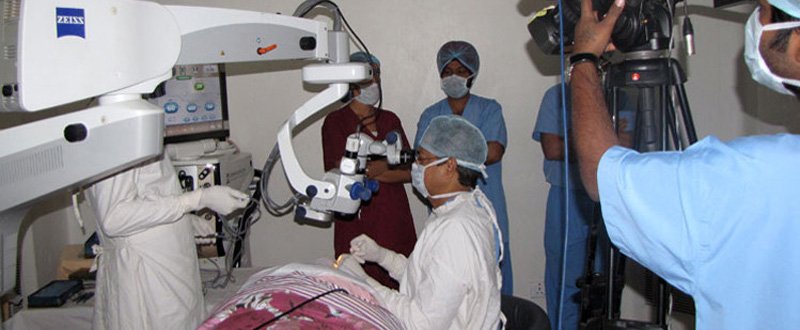The definitive treatment of cataract is primarily surgical. Over the years, the surgical technique has undergone a revolution regarding both, technique and patient outcomes. Today, cataract surgery is both safe and effective. In an attempt to further improve patient comfort, the advancement in technology means faster recovery and better visual rehabilitation.
It began with small-incision cataract surgery with an incision less than 4mm in size, as against a 12-14 mm incision in conventional cataract surgery (called extracapsular cataract extraction). The introduction of phacoemulsification changed cataract surgery forever, heralding the onset of sophisticated mechanization. The most significant advancement in this regard are, one, a decrease in the size of the incision, and two, the use of premium IOLs. The latest in the former is the development of the surgical technique, Microincision Cataract Surgery (MICS); where incision size is less than 2mm in size.
Who needs Microincision Cataract Surgery?
In case you have cataracts, your doctor will try and improve your vision using glasses. In case, if it does not get better with the glasses, or you struggle with glare, he or she will suggest that you to consider cataract surgery. Most doctors find that patient satisfaction and visual recovery are both the best after MICS, and they will be happy to discuss its risks and benefits with you.
All kinds of cataracts, regardless of grade and severity are amenable to treatment with microincision cataract surgery.
How is MICS different from conventional phacoemulsification?
MICS was first described by Jorge Alió in 2002, who defined the technique that relied on principles of bimanuality, new tools, fluidics and a smaller incision. Conventional phacoemulsification uses a larger incision as compared to MICS, as is evident from the terminology itself. In MICS, the incision size is lower than 2.0 mm and ranges from 1.5 to 1.8 mm depending on surgeon preference. The machine used for MICS is more sophisticated. The bimanual irrigation and aspiration handpiece ensure that less ultrasound or phaco energy is used during each surgery. The smaller incision size, as well as the use of less energy, makes this surgery safer and helps in faster healing.
What are the advantages of MICS?
MICS found great acceptability and popularity amongst doctors and patients alike very quickly because of the apparent advantages of the surgical technique. The main benefits of MICS are the better surgical control and prevention of corneal astigmatism because of the surgical procedure, and the decrease of postoperative corneal aberrations. The main advantages of MICS include:
- Smaller incision result in faster healing
- Decreased chances of surgically induced astigmatism, as the incision is smaller. Therefore, less need for glasses after surgery
- Faster recovery of vision, less surgical downtime
- Compatible with premium IOLs, therefore better visual results each time
- Faster healing because of the smaller incision is an added advantage in diabetic patients, elderly and those with other comorbidities
- Better for patients with corneal compromise and zonular weakness due to better fluidics and use of less phaco energy
- No need for anesthesia injections, stitches, bandages or prolonged restriction of activities following surgery. In fact, fewer follow up visits are needed after MICS, and the patient can go back to usual daily routine quickly
- Easy to learn for a surgeon well versed in phacoemulsification, almost flat learning curve
- Compatible with all existing phacoemulsification platforms, so investment in this technology is not very high
What are the disadvantages of Microincision Cataract Surgery?
Even though MICS has been demonstrated to be a superior surgical technique as compared to phacoemulsification, there are a few disadvantages of the technology.
- The incremental cost of cataract surgery: Since MICs requires special instruments and additional training, it does add to the cost of cataract surgery
- In case of patients who are not interested in premium IOLs, the technique loses one of its advantages since the premium IOLs are the most compatible with MICS, providing the best possible visual results.
- Some eye surgeons are of the opinion that intraocular lens with a power greater than +26 Dioptres causes a bit a squeeze, during IOL insertion.
- The surgeon requires additional training in this technique, especially in use of the bimanual irrigation-aspiration handpiece, and in the fluidics-phaco energy combination.
This list is mainly for completion, despite these disadvantages, the advantages that MICS offer to a patient are immense.
Is Microincision Cataract Surgery available in Delhi NCR?
Of course! The Eye7 Chaudhary Eye Centre was the pioneer in introducing this technology to the National Capital and have successfully performed thousands of MICS operations over the years. The Eye7 Chaudhary Eye Centres are equipped with the latest cataract surgery machines and technology to take care of your cataract surgery requirements.
Dr. Sanjay Chaudhary, the founder director of the Eye7 Chaudhary Eye Centre, is a leading proponent of the technique and has even performed live demonstrations of the method at several conferences, being responsible for teaching eye surgeons the finer points of this technique. The cataract surgery team is highly skilled in this technique, and the hospital is offering the top of the range premium IOLs to their patients undergoing microincision cataract surgery at affordable prices.
What is the final verdict on Microincision Cataract Surgery?
MICS is the surgery of choice if you are undergoing cataract extraction. MICS is the latest surgical technique, the superiority of which has been established by several large clinical trials and clinical experience spanning thousands of cases, over the years. If the incremental cost is something you are comfortable with, you must discuss the MICS option with your cataract surgeon because of its established better clinical outcomes.

